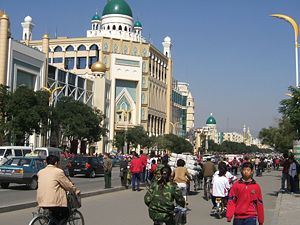|

Hohhot is the capital city of the Inner Mongolian Autonomous Region in the People's Republic of China. It was chosen as Inner Mongolia's capital in 1952, replacing Ulanhot. The name "Hohhot" is Mongolian for "Blue City". In Chinese, the name can be abbreviated to Hū Shì "Hu-town" or translated as Qīng Chéng, also meaning "Blue City". Earlier Chinese administrative names for the city were Guihua and Guisui.
The city dates back to the time of Altan Khan, and is one of the major tourist destinations of Inner Mongolia.
Hohhot was founded by Altan Khan around 1580. Until 1954, Hohhot was referred to by the Chinese as Guisui, or Kweisui, which is the acronym of the two districts of the city:
Guihua: Southeastern old section, business district, established by Altan Khan around 1580.
Suiyuan: Northeastern "New Town", government district. Established in the 17th century by the Manchus.
The two sections later became Guihua District of the Qing Empire, renamed to Guisui County in 1913, and upgraded to a city in 1950.
It was the capital of the defunct Suiyuan Province. Under then Inner Monglian-chairman Ulanhu, the city became the capital of Inner Mongolia in 1952.
Hohhot's look and feel for a visitor seems a combination of Mongol culture, Muslim architecture, mixed with traditional elements of a mid-sized Chinese industrial urban area. Food specialty in the area is mostly focused on Mongolian cuisine and dairy products and there is a large selection of Halal Muslim restaurants. Although there is a significant Mongol population in the city, most ethnic Mongols, especially younger people, tend to only communicate in Mandarin Chinese. There is a linguistic divide between "old-town" folk, with a large Muslim Hui minority, who tend to converse in raw Hohhot dialect, which contains noticeable elements of Jin language of neighboring Shanxi province, which can be difficult to understand for a standard Mandarin speaker. The newer more educated crowd mostly concentrated in Xincheng District, speak Hohhot-based Mandarin Chinese, the majority also with a noticeable, although comprehensible, accent.
Commercially Hohhot is known for being the base of nationally renouned dairy giants Yili and Mengniu.
|
|